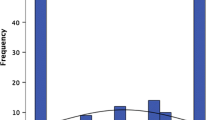Abstract
This study examined the prevalence of Internet use for meeting sexual partners among men who have sex with men. The study also examined HIV risk behaviors among men who reported meeting a sexual partner via the Internet. A sample of 609 men was surveyed while attending a gay pride festival in Atlanta, GA. Participants completed a questionnaire assessing demographic information, Internet use, gay acculturation, AIDS knowledge, attitudes about condoms, global substance use, and sexual behavior. A substantial majority of men (75%) reported using the Internet to access gay-oriented web sites. One third of the sample (34%) reported having met a sexual partner via the Internet. Men meeting sex partners online reported higher rates of methamphetamine use. Men meeting sexual partners over the Internet reported having sex with more male partners in the previous 6 months (M = 8.38, it SD = 19.39) compared with men not meeting partners in this manner (M = 3.13, SD = 4.99, p < .001). Men meeting partners via the Internet also reported higher rates of sexual risk behaviors including unprotected anal receptive intercourse (p < .05) and unprotected anal insertive intercourse (p < .01). The high prevalence of Internet use as a method of meeting sexual partners suggests that sexual networks may be forming over the Internet. The Internet therefore provides opportunities for new HIV primary prevention interventions.
Similar content being viewed by others
REFERENCES
Benotsch, E. G., Kalichman, S. C., & Kelly, J. A. (1999). Sexual compulsivity and substance use in HIV seropositive men who have sex with men: Prevalence and predictors of high-risk behaviors. Addictive Behavior, 24, 857-868.
Carey, M. P., Maisto, S. A., Kalichman, S. C., Forsyth, A. D., Wright, E. M., & Johnson, B. T. (1997). Enhancing motivation to reduce risk of HIV infection for economically disadvantaged urbanwomen. Journal of Consulting and Clinical Psychology, 65, 531-541.
Center for Disease Control and Prevention. (1998). HIV/AIDS surveillance report, 10,27.
Fisher, J. D., & Fisher, W. A. (1992). Changing AIDS-risk behavior. Psychological Bulletin, 111,455-474.
Georgia Division of Public Health. (1998). HIV/AIDS surveillance report. Georgia: Author.
Hays, W. L. (1988). Statistics (4th ed.). Fort Worth: Holt, Rinehart, and Winston.
Hewling-Larsen, M., & Collins, B. (1991, August). Framing messages to promote condom use. Paper presented at the meeting of the American Psychological Association, San Francisco, CA.
Hickson, F., Reid, D., Davies, P., Weatherburn, P., Beardsell, S., & Keogh, P. (1996). No aggregate change in homosexual HIV risk behaviour among gay men attending the Gay Pride Festivals, United Kingdom, 1993-1995. AIDS, 10, 771-774.
Kalichman, S. C. (1998). Preventing AIDS: Sourcebook for behavioral interventions. Mahwah, NJ: Erlbaum.
Kalichman, S. C., Cherry, C., & Brown-Sperling, F. (1999). Effectiveness of a video-based motivational skills-building HIV risk-reduction intervention for inner-city African American men. Journal of Consulting and Clinical Psychology, 67, 959-966.
Kalichman, S. C., Kelly, J. A., & Rompa, D. (1997). Continued highrisk sex among HIV seropositive gay and bisexual men seeking HIV prevention services. Health Psychology, 16, 369-373.
Kauth, M. R., St. Lawrence, J. S., & Kelly, J. A. (1991). Reliability of retrospective assessments of sexual HIV risk behavior: A comparison of biweekly, three-month, and twelve-month self-reports. AIDS Education and Prevention, 3, 207-214.
Kelly, J. A., Murphy, D. A., Sikkema, K. J., McAuliffe, T., Roffman, R. A., Solomon, L. J., et al. (1997). Randomised, controlled, community-level HIV-prevention intervention for sexual-behaviour among homosexual men in US cities. Lancet, 350, 1500-1505.
Kelly, J. A., St. Lawrence, J. S., Stevenson, Y. L., & Hauth, A. C. (1992). Community AIDS/HIV risk reduction: The effects of endorsements by popular people in three cities. American Journal of Public Health, 82, 1483-1489.
Klausner, J. D., Wolf, W., Fischer-Ponce, L., & Zolt, I. (2000). Tracing a syphilis outbreak through cyberspace. Journal of the American Medical Association, 284, 447-449.
McFarlane, M., Bull, S. S., & Rietmeijer, C. A. (2000). The Internet as a newly emerging risk environment for sexually transmitted diseases. Journal of the American Medical Association, 284, 443-446.
Ross, M. W., & Carson, J. A. (1988). Effectiveness of distribution of information on AIDS: A national study of sex media in Australia.New York State Journal of Medicine, 88, 239-241.
Ross, M. W., & Rosser, B. S. (1989). Education and AIDS risks: A review. Health Education Research, 4, 273-284.
San Francisco Department of Public Health. (1999). Director's report. Health commission meeting, August 17, 1999, San Francisco, CA.
Shaw, D. F. (1997). Gay men and communication: A discourse of sex and identity in cyberspace. In S. G. Jones (Ed.), Virtual culture: Identity and communication in cybersociety (pp. 133-145). London, England: Sage.
Weinrich, J. D. (1997). Strange bedfellows: Homosexuality, gay liberation, and the Internet. Journal of Sex Education and Therapy, 22, 58-66.
Author information
Authors and Affiliations
Rights and permissions
About this article
Cite this article
Benotsch, E.G., Kalichman, S. & Cage, M. Men Who Have Met Sex Partners via the Internet: Prevalence, Predictors, and Implications for HIV Prevention. Arch Sex Behav 31, 177–183 (2002). https://doi.org/10.1023/A:1014739203657
Issue Date:
DOI: https://doi.org/10.1023/A:1014739203657




